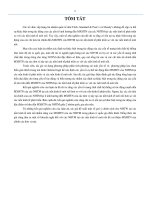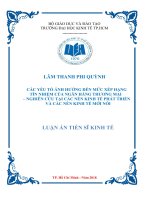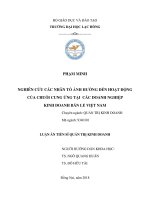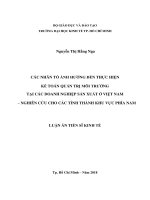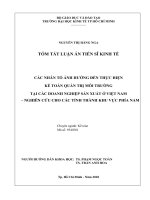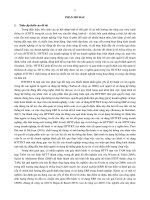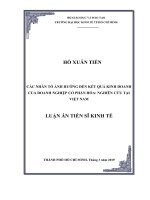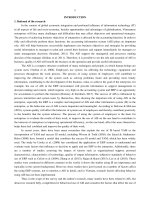Các nhân tố ảnh hưởng đến kết quả kinh doanh của doanh nghiệp cổ phần hóa nghiên cứu tại việt nam tt tiếng anh
Bạn đang xem bản rút gọn của tài liệu. Xem và tải ngay bản đầy đủ của tài liệu tại đây (370.79 KB, 29 trang )
MINISTRY OF EDUCATION AND TRAINING
UNIVERSITY OF ECONOMICS HO CHI MINH CITY
--------------
HO XUAN TIEN
FACTORS AFFECTING PERFORMANCE
OF EQUITIZED ENTERPRISES: A CASE OF
RESEARCH IN VIETNAM
Major: Commercial Business
Code: 9.34.01.21
SUMMARY OF ECONOMIC DISSERTATION
Ho Chi Minh City – 2019
MINISTRY OF EDUCATION AND TRAINING
UNIVERSITY OF ECONOMICS HO CHI MINH CITY
--------------
HO XUAN TIEN
FACTORS AFFECTING PERFORMANCE OF
EQUITIZED ENTERPRISES: A CASE OF
RESEARCH IN VIETNAM
Major: Commercial Business
Code: 9.34.01.21
SUMMARY OF ECONOMIC DISSERTATION
Ho Chi Minh City - 2019
The work was completed at:
University of Economics Ho Chi Minh City
Scientific instructor: Associate Prof. PhD. Bui Thanh Trang
& Associate Prof. PhD. Le Tan Buu
Reviewer 1:
……………………………………………………
……………………………………………………
Reviewer 2:
……………………………………………………
……………………………………………………
Reviewer 3:
……………………………………………………
……………………………………………………
Thesis will be put before the Council to protect thesis at.
……………………………………………………………
At ………on…………
The thesis could be found at the library: ……………….
LIST OF RESEARCH WORKS OF OF THE AUTHOR THAT
RELATED TO THE THESIS
Ho Xuan Tien, 2016. Studying the the relationship between
privatization and corporate performance of state-owned enterprises
after privatization. Journal of Vietnam Trade and Industry Review,
ISSN 0866-7756, 49-53, No. 9, Ha Noi.
Ho Xuan Tien, 2016. Relationship between of type of managerial
ownership and corporate performance of state-owned enterprises
after privatization that were listed in Vietnam securities. Journal of
Vietnam Trade and Industry Review, ISSN 0866-7756, 79-83, No.
10, Ha Noi.
Bui Thanh Trang & Ho Xuan Tien, 2018. The Corporate
entreprneurship theory in the context of the equitization of
companies in Vietnam. Journal of VN Trade and Industry Review,
ISSN 0866-7756, 214-219, No. 11, Ha Noi.
1
CHAPTER 1: RESEARCH OVERVIEW
1.1. The important of the research
The transfer of ownership and control of SOEs from the state to the private
sector is a privatization concept under the World Bank's widely accepted
viewpoint (Shirley, 1992). However, in Vietnam, using the phrase ‘equitization’
is more appropriate, the privatization is a global term while the equitization is
used more in Vietnam and it is understood as the transfer of SOEs to operate in
the form of joint stock enterprises. The agency theory, the property rights
theory, the public choice theory all agree that the private ownership is inherently
more effective than the state ownership in terms of economic benefits (Zhibin,
2004) so the transfer of the ownership and the control of SOEs from the state to
the private sector is the best way to improve the economic landscape.
The equitization is the main point of the restructuring program within SOEs
during Vietnam’s restructuring process, from the SOE system of about 12,000
enterprises (Vu Thanh Tu Anh, 2005), after 25 years since 1992, the
government has managed to reorganize many SOEs and successfully equitized
more than 4,529 enterprises. The number of SOEs grew from nearly 1,500
enterprises in 2010 (Ministry of Finance, 2016), as of the end of September
2017, to 562 enterprises which mainly operate in the areas of ensuring
macroeconomic balances for the economy, security and national defense. The
actual situation of the equitization process in Vietnam shows that the ownership
structure of many equitized enterprises have not changed much, the state is still
a dominant stakeholder and even a dominant decision make in the ownership
structure, especially the State’s representative which is typical in Vietnam.
However, the practice of equitizing SOEs in Vietnam through financial
indicators and Report No.436 / BC-CP on 17/10/2016, show that the majority of
equitized enterprises achieved better performance than before, and there are
even very impressive numbers. Specifically, in the period 2011 - 2015, the
2
performance improved compared to the previous year, such as the charter
capital increased by 73%, the total assets increased by 39%, the equity increased
by 60%, the revenue increased by 29%, the pre-tax profit increased by 49%, the
budget payment increased by 29%, the average income of employees increased
by 33% (Ministry of Finance, 2016). The equitization in Vietnam has not
changed the ownership structure of the whole economy, the state still has a
dominant ownership which has significant control over the capital structure of
equitized enterprises, however the performance are still very positive. This is
contrary to the theory of privatization and the conclusion of most studies on the
inverse proportional relationship between the ratio of the state ownership in
enterprises and performance.
When assessing the performance of equitized enterprises, international and
Vietnamese research often measure the performance of equitized enterprises in
conjunction with different types of owners and performance, according to
objective performance method that uses traditional financial indicators which
are based on secondary financial data sources, hence this is often limited to the
effect of different types of owners and performance, therefore it is impossible to
explain the difference between the theory and the practice with the
characteristics of equitization process in Vietnam. By evaluating the
performance from subjective performance measure which is based on the
primary data source which is considered as opposite to the objective
performance method, this research has expanded the scope of assessment of
performance along with characteristics relating to the changes in ownership
structure, corporate entrepreneurship and equitized enterprises’ expectations in
the context of economic integration. Thereby, the research is able to explain the
cause of the differences between the theory and the practice of equitization in
Vietnam and comes up with management implications for policy makers and
leaders of equitized enterprises. Moreover, the research theoretically contributes
3
to the corporate entrepreneurship that acts as a mediator variable with three
alternatives as strategic renewal, venturing and innovativeness, at the same time,
reinforcing the theory of privatization with the distinctiveness of equitization in
Vietnam compared to other countries.
On that basis, the topic "Factors affecting the performance of equitized
enterprises: A case of research in Vietnam" is selected for this research.
1.2. Goals
Building a relationship model between the factors of the changes in
ownership structure, corporate entrepreneurship, the expectations in
economic integration and the performance of equitized enterprises.
Verifying the relationship between the changes in ownership structure
and
performance;
change
of
ownership
structure
and
corporate
entrepreneurship; corporate entrepreneurship and perofrmance; corporate
entrepreneurship and expected integration; expected integration and the
performance of equitized enterprises.
On that basis, explaining the cause of the difference between the theory
and the practice with the characteristics of equitization in Vietnam, and
proposing the implication of administration as a scientific basis for making
implementation decision on SOEs’ equitization process in the context of
worldwide economic integration.
1.2. Object and scope of the research
Research Objects: According to the research objectives above, the research
objects are the factors affecting the performance of equitized enterprises,
including changes ownership structure, corporate entrepreneurship, expected
integration, equitized enterprises’s performace of and the relationship among
these factors together.
Scope of research: Equitized enterprises are Vietnamese SOEs which have
been transformed and operated in the form of joint stock companies.
4
Survey Objects: Survey objects in this qualitative research are experienced
experts who have been working in the field of equitization for many years.
Survey objects in this quantitative research are key members in equitized SOEs
such as heads of departments, team leaders, board of directors or other
management positions in equitized enterprises.
1. 4. Research methods
This research uses both qualitative and quantitative methods. It is divided
into two phases: preliminary research and official research.
The preliminary research includes the preliminary qualitative research and
the preliminary quantitative research. The preliminary qualitative research used
focused discussion techniques to explore, adjust and complement the scale of
the research model. The preliminary quantitative research was carried out by
direct interviews with research objects to assess the reliability of the scale
before conducting the official research.
The official research used quantitative methods with the following
conventions: Scale reliability test, factor analysis EFA, CFA. Testing the
theoretical model of this research by SEM structure model. The data analysis
was conducted in SPSS and AMOS softwares.
1.5. The research’s new contributions
Theoretical contributions
Although the agency theory, the property rights theory and the public choice
theory have been verified in many studies around the world, however regarding
the characteristics of equitization in Vietnam, it is necessary to have a specific
verification to evaluate, reassert these theories, fill a gap of knowledge in the
relationship between the equitization and the performance in the social and
political environment of Vietnam. In particular, by measuring performance
according to the perceived level, the research results theoretically contribute to
mediator variable of the corporate entrepreneurship accepted in the research
5
model with three components as strategic renewal, venturing and innovativeness
in the relationship between the changes in ownership structure and the
performance of equitized enterprises.
Practical contributions
The equitization process in Vietnam is very different compared to the rest of
the world, it is equitization not privatization, the ownership structure changes
are from a single owner which is the state to many forms of ownership in
equitized enterprises, but the state still holds dominant shares and appoints
representatives in most enterprises. The agency theory, the public choice theory
and the property rights theory claim that the state ownership is ineffective, but
the practical situation in Vietnam shows that the performance in these
enterprises are very positive. There are many studies on the equitization and the
performance around the world as well as Vietnam. However, most of them only
assess the performance by objective performance method which uses secondary
financial data sources from the financial statements, so it can’t explain the
difference between the practice and the theory when it comes to evaluate the
performance of Vietnamese equitized enterprises in the past. By using the
subjective performance method based on the perceived level, the research
results explain the cause of these differences. Based on the research results,
some policy implications are proposed to help the authorities improve the
equitization process in the next phases.
1.6. Research Structure
The research includes five chapters:
Chapter 1: Research Overview
Chapter 2: Theoretical basis and Research model
Chapter 3: Research methods
Chapter 4: Analysis of results and verification of research model
Chapter 5: Conclusion and implications for management
6
CHAPTER 2: THEORETICAL BASIS AND RESEARCH MODEL
2.1. Definition of privatization and equitization
2.1.1. The concept of privatization
The term “Privatization” has many interpretations (Farazmand, 2001) in the
broadest sense of transferring activities or functions from the State to the private
sector, especially in the field of production and services (Starr, 1988), the
simplest and concise interpretation is the concept of Hashemi & Abolghassem
(1993), the market orientation is the most comprehensive definition to describe
the nature of privatization. However, the definition that is accessible, popular
and widely accepted belong to the World Bank and IMF (Zhibin, 2004), the
privatization is the transfer of ownership or control of SOEs from the
government to the private sector.
2.1.2. The concept of equitization
Privatization is a global phenomenon, an inevitable trend for many decades
of many economies around the world (Yuliya, 2011) and Vietnam as well.
However, due to the creative application according to this specific method in
Vietnam, the term “Equitization” is used more often. Under Decree
64/2002/ND-CP dated 06/19/2002, the equitization means the conversion of
SOEs into joint stock enterprises, according to the four forms of equitization as
follows: Maintaining the existing State ownership in enterprises, issuing shares
to attract more capital; selling a part of existing State ownership in enterprises;
selling all existing state ownership in enterprises; implementing forms 2 or 3
combined with issuing shares to attract more capital.
2.2. Privatization theory
2.2.1. Agency theory
According to Jensen & Merkling (1976), there exists a conflict of interests
between the Principal and the Agent, resulting in employers facing opportunistic
behavior and moral hazard from representatives.
7
2.2.2. Property rights theory
The Property rights theory was initiated by Coase (1960), Furubotn &
Pejovich, (1972) and Alchian & Demsetz (1973), which argued that differences
in the ownership will affect the motivation and economic behavior of the owner.
Private ownership will improve the motivation, benefits and behavior of owners,
managers and employees. Meanwhile, the lack of clarity and ambiguity in
public ownership will negatively affect the dynamics of managers, negatively
impact important decisions and deal with the consequences of decisions made
by general ownership status
2.2.3. Public choice theory
The public choice theory was initiated by Buchanan (1978), Ott & Hartley
(1993); Gubin et al., (1999), the public choice theory argues that public owners'
business results would not be good due to the political objectives and personal
political interests of politicians. Gubin et al., (1999) argues that this theory also
applies to economic transition in various countries.
2.3. Measuring performance
According to Dawes (1999), measuring performance using secondary
financial data based on financial indicators known as objective performance
measure. Contrary to this method is the method of measuring performance by
using primary data based on the perceived level of the respondents about
performance with scales indicating the level from very bad to very good or very
little, this is known as the subjective performance measure. The equivalence and
relevance of using perceived level of perception is viewed as the opposite of the
measure based on objective data discussed by many researchers (Murphy &
Callaway, 2004). Two studies by Dess & Robinson (1984); Gupta &
Govindarajan (1984) are considered as the most strongly supporters of the use
of perceived measure to replace objective measurement methods (Murphy &
Callaway, 2004). Although there are potential drawbacks in measurement (Keh
8
et al., 2007), Dess & Robinson (1984); Gupta & Govindarajan (1984) argued
that with the absence of secondary data, it is possible to assess business
performance of enterprises by other approaches through primary data collection,
by asking directly about business situation according to the perceived level.
2.4. Research model and hypotheses
2.4.1. Research concepts
2.4.1.1. Change of Ownership Structure
The change of Ownership Structure in the research is understood as the state
ownership transfer from SOEs to other forms of ownership when equitizing or
from state ownership to other types of ownership since the state continues to
divest after that.
2.4.1.2. Expected integration
Vietnam joined WTO in 2007 which has created opportunities as well as
challenges for domestic enterprises, Tho & Trang (2011) in research of WTO,
Marketing, the ability to change within Vietnamese enterprises, defined expected
WTO opportunity as the expectation on the benefits that WTO could bring to
enterprises when Vietnam is a member of this organization. Based on the
definition of expected WTO opportunity, the concept of expected integration in
the research is understood as an expectation of equitized enterprises on
opportunities to seek partners and opportunities to change corporate governance
in the direction of international rules since Vietnam strongly integrates into the
world economy.
2.4.1.3. Corporate Entrepreneurship - CE
Since 1980, researchers have expanded the concept of measuring the trend of
businesses towards entrepreneurship in association with the issue of enterprise
comprehensive renewal to survive in the harsh changes of environment
(Baumol, 1986; Burgelman, 1983; Kanter, 1989) or create new ones that bring
new vitality to the development process of businesses (Schendel, 1990). Guth &
9
Ginsberg (1990) is considered to be a pioneer in expanding the measuring of
entrepreneurship trends of businesses, and believes that this trend includes two
main points: internal innovation with new venture creation and transforming the
development of businesses through strategic renewal. Zahra (1991) inherited the
CE concept of Guth & Ginsberg (1990) and previous studies, then approached
the entrepreneurship concept with the corporate entrepreneurship from the
centralized point of view of actual entrepreneurship activities in businesses, not
the trend towards entrepreneurship as the measurement of the concept of EO.
Zahra (1991, 1993) argued that CE is a multidirectional concept consisting of
three adventurous components venturing; innovativeness and strategic renewal
and building measurement scale with 14 observed variables.
2.4.2. Research hypotheses
2.4.2.1 Corporate entrepreneurship and performance
The corporate entrepreneurship theory to understand enterprises explains the
advantages of pioneering, temporary monopoly of the company, competing with
competitors in the industry, always looking for ways to compete, creating new
fluctuations and destroy the old ones (Nguyen Thanh Long, 2012), innovating
the existing strategies to boost the ability to meet the market demands (Antocic
& Hisrish, 2003). The enterprises that have the corporate entrepreneurship are
always proactive and pioneering in proposing, implementing new ideas and
production processes to meet the internal and external environment to create
pioneering advantages (Keh et al., 2007). The corporate entrepreneurship is seen
as an important factor of the organization, bringing a new revitalization to the
future of enterprises (Schollorhhammer, 1982), not only important for large
enterprises but also necessary for medium and small enterprises (Covin &
Slevin, 1991), for developed countries and economic transition countries
(Antoncic & Hisrich, 2003). The corporate entrepreneurship is related to the
process of implementing the strategy, in which the core point is to maintain the
10
vision in the future (Lumpkin & Dess, 1996). In a dynamic and competitive
business environment, the profits earned in the future are uncertain, so
businesses need to constantly seek new opportunities to exploit these
opportunities effectively (Zhou et al., 2007).
Many previous researchers also agreed that the corporate entrepreneurship is
an important factor contributing to enterprises’ financial profits (Kuhn et al.,
2010), enterprises with high corporate entrepreneurship achieve higher financial
profits compared those with less interest in it (Wiklund & Shepherd, 2005).
According to Antocic & Hisrish (2003), the corporate entrepreneurship
positively impacts their performance. Business opportunities and barriers in the
modern business environment are constantly changing, only businesses with the
corporate entrepreneurship of mastering their businesses can realize and grasp
these opportunities quickly to actively respond to changes and create advantages
as initiators (Keh et al., 2007). On that basis, the research hypothesis H1 is stated
as follows:
H1: The corporate entrepreneurship has a positive impact on the performance of
equitized enterprises.
2.4.2.2 Change in ownership structure and corporate entrepreneurship
In any form, the privatization brings two positive effects for enterprises,
namely stastic efficiency and dynamic efficiency, in which dynamic efficiency
is seen as a change to improve corporate governance, stimulating
innovativeness, creation in businesses (Shirley, 1992). Privatization has affected
and changed the consciousness, management thinking, created opportunities for
the development of the private sector, especially the foreign economic sector
during capital ownership structure process, supporting enterprises to replace
change governance system according to modern trends and internationalization
(Paul, 2013). Privatization can be seen as a core decision for businesses to be
entrepreneurial (Antoncic & Hisrish, 2003).
11
According to the public choice theory, there is no innovation encouragement
and absolutely no concept of corporate entrepreneurship in SOEs, SOEs’
appointed leaders are not related to the high-level personnel market but due to
dominant political factors (Ana et al., 2010). Moreover, SOEs have a role to
control the commodity market and are often protected when bankrupt (Pryke,
1971), so this results in company value being not in the top target of these
enterprises and also does not give these enterprises the pressure to create
corporate entrepreneurship (Lioukas et al., 1993).
Privatization is the beginning of a process of change in businesses (Cuervo
& Villalonga, 2000), enterprises are seen as being untied, released from
management decisions, leading to a dramatic change, the initiative of business
leaders with reshaping the strategic structure, business goals, development
strategies and work motivation to support activities that increase shareholder
value (Zahra et al., 2006), originally creating corporate entrepreneurship (Ana et
al., 2010). Privatization has become a very important tool in economic policy
(Uhlenbruck & De Castro, 1998) and helps to improve business results
compared to previously being as an SOE (Cuervo & Villalonga, 2000). One of
the reasons for privatization is to allow enterprises to form a corporate
entrepreneurship through increasing initiatives, creativity and risk-taking in
businesses (Ana et al., 2010).
The agency theory shows that management style affects the level of
ownership of enterprises (Ana et al., 2010), many studies show that there is a
positive relationship between different types of owners such as department
organizational
ownership,
management
ownership,
and
the
structure
composition with the corporate entrepreneurship (Zahra, 1996). Antoncic &
Hisrich (2003) analyzed the relationship between the change in ownership
structure and the corporate entrepreneurship in the former socialist countries, the
12
research results showed that the reduction of state ownership shall increase the
ownership of enterprises. On that basis, hypothesis H2 is stated as follows:
H2: The changes in ownership structure has a positive impact on corporate
entrepreneurship of equitized enterprises.
2.4.2.3 Change of ownership structure and performance
For foreign ownership, regarding the property rights theory and public
choice theory, foreign ownership has a positive impact on equitization, most of
the studies also conclude that the foreign ownership has positive impacts on
performance.
For administrative ownership, according to the agency theory, the interests
of representatives in joint stock enterprises are not consistent with the interests
of shareholders. The separation of ownership and management rights in jointstock enterprises causes potential conflicts between shareholders and managers,
for managers who pursue their own interests that contradict to the interests of
shareholders. One method of reducing this conflict is to encourage managers
own their shares, however, according to Jensen & Meckling (1976), the larger
the share ownership of management members, the more likely they tend to make
a decision that maximizes the value of the owner property, which means
maximizing their own asset value, this assumption is called the convergence of
interest. In addition, Morck & et al., (1988) argued that high-level
administrative ownership can lead to entrenchment, a subjective phenomenon of
managers when they take control of the company.
For state ownership, the agency theory, the property rights theory, the public
choice theory say that state ownership is less effective than other forms of
ownership because of differences in items goals, motivation and work of human
self-interest (Sun & Tong, 2003; Gupta, 2005). Many studies prove that state
ownership is less effective than private ownership due to the lack of work
motivation (Megginson & Netter, 2001; Shirley & Walsh, 2000; Xu & Wang
13
(1999), Qi et al. (2000), Sun & Tong (2003) and political intervention in
economics (Faccio, 2006), the state is not a shareholder who only wants to
maximize profits but also has to carry out many different objectives
simultaneously (Aharoni, 1986). However, there is evidence that the high level
of state ownership in enterprises and political intervention have a negative
relationship (Fan et al., 2006; Yuan, 2008) as well as positive relationship
(Berkman et al., 2009; Francis et al., 2009; Li et al., 2008) with performance.
With state-owned characteristics in developing countries, there is often a
large state intervention in economic activities, state ownership has a negative
impact on the performance of a company since the representatives from the state
are not really shareholders of the company, so the high level of state ownership
in equitized enterprises can negatively affect the business performance. Based
on the above analysis, H3 research hypothesis is stated as follows:
H3: Change in ownership structure has a positive impact on the performance of
equitized enterprises.
2.4.2.4 Corporate entrepreneurship and Expected integration
The corporate entrepreneurship demonstrates the ability of enterprises to
take the initiatives and determinations to pursue their goals and they are willing
to take risks in business. Entrepreneurial orientation is a basic form of dynamic
capabilities of the business as it helps increase the proactive habits and
determination to pursue its goals and to be ready to accept business risks
(Nguyen Dinh Tho & Nguyen Thi Mai Trang, 2009). Therefore, businesses with
high corporate entrepreneurship always pursue business opportunities to
discover opportunities and barriers (Keh et al., 2007).
Successful internationalization is supported by international strategic
investors, the formation of FTAs creates important effects on the investment
environment and behavior of investors, the formation of FTAs can promote both
domestic and foreign investment flows, investment flows between FTA
14
members as well as with outside FTAs. The establishment of FTAs has
significantly reduced distortions in the investment, production environment of
its members, promoted investors' business activities, and brought about huge
market access opportunities with higher demands (Bui Truong Giang, 2008).
Attention-based view of the firm (Ocasio, 1977) shows that businesses will
take action to adjust their strategy, mission and vision when enterprises are
interested in other business, important events and developments in the market.
The organizational expectation theory (Cyert & March, 1992) shows that when
businesses have expectations about changes in the business environment, the
conglomerate enterprises will take action to adjust with that expectation. On that
basis, the H4 hypothesis is stated as follows:
H4: The corporate entrepreneurship has a positive impact on the expected
integration of equitized enterprises.
2.4.2.5 Expected integration and performance
Arguments for regional integration suggest that economic integration has a
positive impact on all members (Krugman & Obstfeld, 2002), the removal of
trade barriers, the formation of markets and the influence of the two economic
and political aspects of integration have created opportunities for economic
growth, positively impacting members’ economic growth (Rose, 2000; Rose &
Eric, 2001).
Although the phenomenon Britain referendum in 2016 that resulted in the
decision to leave the EU (Brexit) has affected the integration trend of the world,
the economic integration is still a popular trend for countries which are pursuing
prosperity and maintaining bilateral and multilateral cooperation (Danson &
Deogratias, 2016). Studies of Baldwin & Seghezza (1996); Baldwin et al.,
(1996), found a positive correlation between investment provisions in FTAs
with an increase in trade and investment flows, the formation of FTAs with
strong stimulating effects. With foreign and domestic investment, the rate of
15
return on investment of all members in a regional integration agreement may
increase even if the capital market is abundant.
The impact of the economic integration process associated with the change
in ownership structure in enterprises is the cause of the improvement of business
performance of enterprises in developing countries, the economic integration
facilitates equitized enterprises to internationalize enterprises, approaching
modern enterprise management methods, advanced technology and investment
capital to equitize enterprises to integrate into the global economy (Bachiller,
2016). On that basis, the H5 hypothesis is stated as follows:
H5: The expected integration has a positive impact on the performance of
equitized enterprises.
2.5.3. Research models
On the basis of these hypotheses, the proposed theoretical model is:
Change of Ownership Structure
H3
Strategic Renewal
H2
H1
Venturing
Innovativeness
Corporate Entrepreneurship
Performance
H4
H5
Expected Integration
Figure 2.1: Proposed theoretical model
16
CHAPTER 3: RESEARCH METHODS
3.1.1. Research method
3.1.1.1. Preliminary research
Preliminary research is done through qualitative and quantitative methods.
Preliminary research on qualitative factors explores the business results of
equitized enterprises, preliminary qualitative research adjusts the scale from the
existing scales of previous studies. Participants in the discussion were 7 experts
in the field of equitization (Appendix 2). After the scale is added and adjusted, a
preliminary quantitative research develops a survey questionnaire for official
research. Subjects of the survey are the heads of departments, team leaders,
board of directors and other management positions in equitized enterprises.
Sample size is n = 120 conducted from December 1, 2016 to March 1, 2017.
3.1.1.2. Official research
The official research used quantitative method with similar survey objects as
preliminary quantitative research but with a large sample of n = 320. Convenient
sampling methods and direct investigation and e-mail methods are carried out
from August 20, 2017 to December 31, 2017.
3.1.2. Research process
Theoretical
basis
Cronbach ‘s
alpha
Analysis of
discovery
factors
Factors
and
Qualitative
research
(discover, adjust
Consider the correlation of the total variable and
Cronbach’s alpha
Prelimina
ry scale
Preliminary
quantification (n = 120)
Evaluate indicators in exploratory factor analysis
Official
scale
Cronbach’s
ScaleEFA,
alpha
Evaluate indicators in Cronbach’s alpha, EFA, CFA
SEM
Evaluation of estimation indicators, relevance of
Official quantitative (n = 320)
17
The scales in the topic are inherited from previous studies and modified to
suit Vietnamese language and context in the qualitative research. The scale of
ownership structure change is inherited from the scale of Immaculate & et al.,
(2011), p.255; scale of integration expectations from Tho & Trang, (2011),
p.720; entrepreneurship scale from Zahra's scale, (1996), p.1723; business
results scale from Murphy & et al., 1996. A total of 22 observed variables are
used to measure research concepts. The scales are measured as Likert scales
with 7 levels, of which 1: completely opposed and 7: completely agree.
Methods of data analysis in official research
Data collected from quantitative survey questionnaires were processed by
SPSS software to evaluate Cronbach's alpha coefficients and EFA analysis.
Then, CFA analysis and SEM linear structure model through AMOS software
with ML estimation method were used to test theoretical models and
hypotheses. Bootstrap method was used to re-estimate the parameters of the
theoretical model compared to the ML method to reaffirm the confidence level
of the estimates in the theoretical model. Multi-group structural analysis was
carried out to re-examine the relationship between the changes in ownership
structure and the business results of equitized enterprises, according to the ratio
of State ownership held at enterprises <= 49% and > = 51%. Finally, the
corporate entrepreneurship variable is tested in the relationship between the
changes in ownership structure and the business results of equitized enterprises.
18
Table 3.13 Contents of scale used for official research
STT
Code
Strategic
Renewal
Survey
EXPECTED INTEGRATION
The policy of economic integration in recent years has helped
1
EI1
Our company seeks many strategic investors.
2
EI2
Our company finds many new business partners.
3
EI4
Our business is more straight-forward.
CHANGES IN OWNERSHIP STRUCTURE
Equitization
4
OS1
Foreign shareholders should be major shareholders.
5
OS5
Organization shareholders should be major shareholders.
6
OS6
The State should reduce its role as a shareholder.
CORPORATE ENTREPRENEURSHIP
When converting into a joint stock company, our company:
Reorganizing business activities to increase the cooperation and
ENP2
communication between units.
ENP3 Initiating programs to improve product / service quality.
ENP4 Changing strategies to compete.
ENP5 Investing in new areas.
ENP6 Diversifying new areas in Vietnam
ENP7 Expanding international operations
ENP8 Sponsoring start-up projects (Startup)
ENP9 Spending a lot of money on research and development (R&D).
ENP10
Introducing new products / services to the market.
ENP11
Using superior technical solutions.
ENP12
Pioneering in developing new products / services in the global market
and in Vietnam.
PERFORMANCE
When converted into a joint stock company, our company:
18
P1
Achieving the desired profit (ROS).
19
P2
Achieving good growth rate.
10
P3
Opening new markets.
21
P4
Developing new products.
22
P5
Increasing employee salary.
Venturing
Innovativeness
19
CHAPTER 4: ANALYSIS OF RESULTS AND
VERIFICATION OF RESEARCH MODEL
4.1. Research sample
During the official survey, 825 surveys were sent to the research subjects.
350 surveys received feedback, after the data cleaning process, 320 surveys met
requirements, achieving the rate of 37.64%.
4.2. Result of CFA confirmatory factor analysis
Critical measurement model
The critical model has 194 degrees of freedom. Chi-square = 422.531 with
a value of P = 0,000, because Chi-square has drawbacks of depending on the
sample size, considering other indicators, it is shown that this model is
consistent with market data: GFI = 0.898 ; TLI = 0.923; CFI = 0.936; RMSEA =
0.061. There is no correlation between the errors of the observed variables, so
the components in the critical measurement model achieve uni-directional
nature. The standardized weights meet the permissible standard (> = 0.5) and
are statistically significant, so the concepts in the critical measurement model
achieve convergence values. The correlation coefficient between concepts with
accompanying standard deviations shows us that these coefficients are less than
1, statistically significant. Therefore, the concepts in the critical measurement
model achieve discriminant value. Detailed results can be seen in Table 4.8,
Appendix 8.3 and 10.1
4.3. Results of SEM linear structure model
4.3.1. Testing proposed theoretical model
This theoretical model has 203 degrees of freedom, Chi-square value =
491.211 with P = 0.000 but all other criteria are satisfactory: GFI = 0.878; TLI =
0.909; CFI = 0.919; RMSEA = 0.067. The estimation results of the theoretical
model are presented in Figure 4.3 (Appendix 8.4 shows the remaining criteria).
Thus, it can be concluded that this model is suitable for data collected.
20
4.3.2. Testing hypotheses of the research model
5 research hypotheses are tested and shown in Table 4.10, this result shows
that three relationships are statistically significant, two relationships are not
statistically significant. The relationship between expected integration and
performance of equitized enterprises (hypothesis H5); The relationship between
the change of ownership structure and performance of equitized enterprises
(hypothesis H3) are not statistically significant (Sig.> 0.05), (details of other
estimates can be seen in Appendix 8.4).
Table 4.10: Regression coefficients of the proposed theoretical model
Estimate
Non-standardized
Standardized
Relationship
Corporate entrepreneurship
Eexpected integration
Performance
Performance
Performance
←
←
←
←
←
Change of ownership
structure
Corporate entrepreneurship
Corporate entrepreneurship
Expected integration
Change of ownership
structure
SE
CR
P
0,788
0,637
0,065
9,728
0,000
0,887
1,067
-0,250
1,250
1,319
-0,220
0,121
0,402
0,225
10,360
3,285
-0,975
0,000
0,001
0,330
-0,065
-0,065
0,125
-0,520
0,603
4.3.3. Verification of adjustment theory model
After the hypothesis H3 and H5 are out of the proposed theoretical model,
the estimation results of the official theoretical model are presented in Figure
4.4 (Appendix 8.4), this theoretical model has 205 degrees of freedom.
Although the Chi-square value = 492.278 with P = 0.000 but all other criteria
meet the requirements: GFI = 0.877; TLI = 0.909; CFI = 0.919; RMSEA =
0.066 (Appendix 8.4 shows the criteria for evaluating the remaining
compatibility). Thus, it can be concluded that this adjustment model is suitable
for data collected from the market.
Table 4.11 presents the estimates of the main parameters in the model,
which shows three statistically significant relationships (P <5%), including the
relationship
between
change
of
ownership
structure
and
corporate
entrepreneurship (H2), corporate entrepreneurship and performance (H1),
corporate entrepreneurship and expected integration (H4).
21
Table 4.11: Regression coefficients of the adjustment theory model
Relationship
Corporate entrepreneurship
Performance
Expected integration
←
←
←
Change of ownership structure
Corporate entrepreneurship
Corporate entrepreneurship
Estimate
Nonstandardiz
ed
0,791
0,645
0,767
0,944
0,875
1,221
Standar
dized
SE
CR
P
0,065
0,089
0,116
9,879
10,554
10,567
0,000
0,000
0,000
4.4. Verification of the adjustment theory model using bootstrap
This study uses bootstrap method with repeated sample number of N =
1,000. The estimated results shown in table 4.12 has difference but not
significant. Therefore, it can be concluded that the estimates in the adjustment
theory model are reliable, (the results of calculating the estimates of the
bootstrap method can be seen in Appendix 8.5).
4.5. Analysis of multi-group structure
Analysis of multi-group structure is aimed to test whether there is the
difference in the impact degree of owner structure change on the performance of
equitized enterprises in proportion holding the state capital in enterprises of 49%
and 51%. The verification result of hypothesis H3 is rejected (Sig. = 0.698); H5
is rejected (Sig. = 0.499), other hypotheses H1, H2, H4, are statistically
significant (Sig. = 0,000), (Appendix 8.6). Thus, when dividing the samples into
two groups with proportion holding the state capital of <= 49% and> = 51%, the
verification result of hypothesis H3 is still rejected, ie with the collected data set,
there is not the relationship between change in ownership structure and
performance of equitized enterprises in Vietnam.
4.6. Verification of mediator variable of corporate entrepreneurship
The results show that when there is no corporate entrepreneurship variable,
the regression weight between the change of ownership structure and
performance is 0.613 and statistically significant (Sig = 0.000), when there is
corporate entrepreneurship variable, the regression weight between the change
of ownership structure and performance is -0,424 and not statistically significant
(Sig. = 0.162), (Appendix 8.7). This verification result shows that when there is
